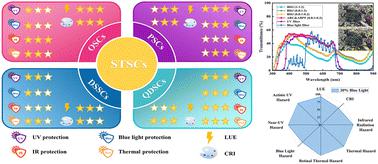当前位置:
X-MOL 学术
›
Energy Environ. Sci.
›
论文详情
Our official English website, www.x-mol.net, welcomes your
feedback! (Note: you will need to create a separate account there.)
Human-friendly semitransparent organic solar cells achieving high performance
Energy & Environmental Science ( IF 32.4 ) Pub Date : 2024-07-12 , DOI: 10.1039/d4ee01659a Zonghao Wu 1, 2 , Beibei Shi 1, 2 , Jiangsheng Yu 3, 4 , Mengzhen Sha 1 , Jiangkai Sun 1 , Dongcheng Jiang 1 , Xin Liu 4 , Wenxiao Wu 5 , Yang Tan 1 , Huiyuan Li 6 , Shufen Huang 1 , Jingjing Wang 7 , Junwei Liu 7 , Chao Zhang 8 , Xiaoling Ma 9 , Liyong Cui 10 , Long Ye 7 , Fujun Zhang 9 , Bingqiang Cao 11 , Yuguo Chen 5 , Ziwu Ji 2 , Feng Chen 1 , Xiaotao Hao 1 , Gang Li 3 , Hang Yin 1
Energy & Environmental Science ( IF 32.4 ) Pub Date : 2024-07-12 , DOI: 10.1039/d4ee01659a Zonghao Wu 1, 2 , Beibei Shi 1, 2 , Jiangsheng Yu 3, 4 , Mengzhen Sha 1 , Jiangkai Sun 1 , Dongcheng Jiang 1 , Xin Liu 4 , Wenxiao Wu 5 , Yang Tan 1 , Huiyuan Li 6 , Shufen Huang 1 , Jingjing Wang 7 , Junwei Liu 7 , Chao Zhang 8 , Xiaoling Ma 9 , Liyong Cui 10 , Long Ye 7 , Fujun Zhang 9 , Bingqiang Cao 11 , Yuguo Chen 5 , Ziwu Ji 2 , Feng Chen 1 , Xiaotao Hao 1 , Gang Li 3 , Hang Yin 1
Affiliation

|
Semitransparent photovoltaic (ST-PV) devices transmitting enough light and generating electricity have become one of the research frontiers in emerging PV systems including organic, perovskite, quantum dot and dye-sensitized solar cells in recent years. Such semitransparent devices can be integrated into house curtain walls, intelligent windows and plant greenhouse, simultaneously increasing the solar energy collection area and architectural aesthetics. Although the light utilization efficiencies (LUEs) of single-junction devices have exceeded 3.5%, research studies about ST-PV devices are still missing an important element: the human-to-device interaction, as the long-time exposure to solar irradiation or even such semitransparent modules would unfortunately cause photoinduced diseases such as erythema, skin aging, cataracts and even blindness. Herein, we systematically evaluated the photobiological safety of mainstream ST-PV devices and fabricated a series of high-performance human-friendly ST-PV devices with LUE values exceeding 5.0% and low skin/eye damage levels for human beings. Impressively, such solar cells combine ultraviolet and blue light filtering structures to achieve comprehensive protection against light hazards and record safety working extremum (SWE) values for all-around skin and eye protection. This work not only establishes an important principle to evaluate the human-to-device interaction of ST-PV devices for the first time, but also demonstrates an effective integrated optesthesia-dermato control method by using aperiodic band-pass filters (ABPF) without sacrificing device performance.
中文翻译:

人类友好型半透明有机太阳能电池实现高性能
近年来,传输足够光并产生电力的半透明光伏(ST-PV)器件已成为包括有机、钙钛矿、量子点和染料敏化太阳能电池在内的新兴光伏系统的研究前沿之一。这种半透明装置可以集成到房屋幕墙、智能窗户和植物温室中,同时增加太阳能收集面积和建筑美学。尽管单结器件的光利用率(LUE)已超过3.5%,但有关ST-PV器件的研究仍然缺少一个重要因素:人与器件的交互,因为长时间暴露在太阳照射或阳光下不幸的是,即使是这样的半透明模块也会导致光诱发的疾病,例如红斑、皮肤老化、白内障甚至失明。在此,我们系统评估了主流ST-PV器件的光生物学安全性,并制造了一系列高性能的人类友好型ST-PV器件,其LUE值超过5.0%,对人类皮肤/眼睛损伤程度较低。令人印象深刻的是,这种太阳能电池结合了紫外线和蓝光过滤结构,实现了对光危害的全面防护,并记录了皮肤和眼睛全方位保护的安全工作极值(SWE)。这项工作不仅首次建立了评估 ST-PV 设备人机交互的重要原理,而且还展示了一种使用非周期带通滤波器(ABPF)的有效集成视觉-皮肤控制方法,而不牺牲设备性能。
更新日期:2024-07-12
中文翻译:

人类友好型半透明有机太阳能电池实现高性能
近年来,传输足够光并产生电力的半透明光伏(ST-PV)器件已成为包括有机、钙钛矿、量子点和染料敏化太阳能电池在内的新兴光伏系统的研究前沿之一。这种半透明装置可以集成到房屋幕墙、智能窗户和植物温室中,同时增加太阳能收集面积和建筑美学。尽管单结器件的光利用率(LUE)已超过3.5%,但有关ST-PV器件的研究仍然缺少一个重要因素:人与器件的交互,因为长时间暴露在太阳照射或阳光下不幸的是,即使是这样的半透明模块也会导致光诱发的疾病,例如红斑、皮肤老化、白内障甚至失明。在此,我们系统评估了主流ST-PV器件的光生物学安全性,并制造了一系列高性能的人类友好型ST-PV器件,其LUE值超过5.0%,对人类皮肤/眼睛损伤程度较低。令人印象深刻的是,这种太阳能电池结合了紫外线和蓝光过滤结构,实现了对光危害的全面防护,并记录了皮肤和眼睛全方位保护的安全工作极值(SWE)。这项工作不仅首次建立了评估 ST-PV 设备人机交互的重要原理,而且还展示了一种使用非周期带通滤波器(ABPF)的有效集成视觉-皮肤控制方法,而不牺牲设备性能。











































 京公网安备 11010802027423号
京公网安备 11010802027423号